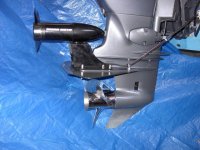The slowest speed my Tom Cat will run, with one of the 150 Yamahas running at idle, is about 2.6 mph. I want to have the ability to slow the boat down to about 1 mph for certain salmon trolling situations. So far I have identified four solutions, none completely satisfactory.
1. Install a 8 hp Yamaha high torque motor with power tilt and remote controls. This is the most serious solution, but it would make it difficult, if not impossible, to continue to use the boarding ladder (which I use often on land.) Plus, there is the problem of getting the expense ($3500+) past the Minister of Finance. On the other hand, to paraphrase a great American, "Extremisim in the pursuit of fish is no vice."
2. HappiTroll(s). (Need 2 to equalize running times for both engines.) I have Permatrims installed and doubt if the HappiTroll would fit. Plus, I suspect it would negatively affect the water flow around the engines.
3. Drift sock. I have one and need to try it out. Am worried about fouling the fishing lines and/or props.
4. (This is my latest idea). Re-prop the engines for fishing. That is, install high-torque props that would not provide as much top-end speed but would slow the boat down at idle. I've not changed a prop before (never needed to, knock on wood) but it doesn't look too hard to do.
Any ideas about these approaches, or ideas for other solutions?
Thanks!
Warren
1. Install a 8 hp Yamaha high torque motor with power tilt and remote controls. This is the most serious solution, but it would make it difficult, if not impossible, to continue to use the boarding ladder (which I use often on land.) Plus, there is the problem of getting the expense ($3500+) past the Minister of Finance. On the other hand, to paraphrase a great American, "Extremisim in the pursuit of fish is no vice."
2. HappiTroll(s). (Need 2 to equalize running times for both engines.) I have Permatrims installed and doubt if the HappiTroll would fit. Plus, I suspect it would negatively affect the water flow around the engines.
3. Drift sock. I have one and need to try it out. Am worried about fouling the fishing lines and/or props.
4. (This is my latest idea). Re-prop the engines for fishing. That is, install high-torque props that would not provide as much top-end speed but would slow the boat down at idle. I've not changed a prop before (never needed to, knock on wood) but it doesn't look too hard to do.
Any ideas about these approaches, or ideas for other solutions?
Thanks!
Warren

